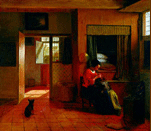










25.
The Built Environment and the Imaginary;
Women's Space in Early Modern Spain and Italy
Organizers:
The interdisciplinary focus is a major thrust of this workshop. The six organizers come from three different fields within Early Modern Studies: history, art/architectural history and literature. All, however, challenge disciplinary boundaries in their own work, and acknowledge the value of cross-disciplinary approaches for feminist scholarship. Our workshop is also unusual in presenting an exchange of ideas on Italy and Spain—two countries that are normally, and regretably, considered in isolation, although they shared political, religious and cultural conditions. We seek to redress that imbalance by examining correspondences in woman’s relationship to sacred and secular space. We define the Early Modern period broadly--chronologically but also culturally—and consider material culture as well as artistic production.
Section I: In Spain, the spatial organization of religious communities is revealed in convent design, showing both the limitations and possibilities of physical enclosure. How and where were women confined, and to what purposes? What were their responses--creative, internalized, or disobedient? In the radically different case of the moriscas, it will be suggested that women accommodated changes imposed on their built environment and transformed their homes into what might be called "spaces of resistance."
Section II: The analysis of Early Modern Women in Italy considers the architecture and art of enclosed communities. The Council of Trent’s decree on clausura dictated the terms of communal living, and Post-Tridentine ecclesiastics, like Carlo Borromeo, formulated rules on art and architecture. How did design and figurative decoration relate to communal practices? We present two alternative spaces--a convent for upper-class religious in southern Italy, and a conservatory for dispossessed women in Rome—both of which retain important aspects of their interior design.
Section III: Center and Margins: Women and the Spatial Imaginary in Early Modern Spain--The spatial imaginary to which marginalized women are relegated in early modern Spanish literature and history encompasses the limits and violations of living areas, but also the shifting geographical spaces across which moriscos and gypsies were persecuted. Literary descriptions include Calderon's play, Amar despues de la muerte, which describes the dispersal of the moriscos across Spain. Similarly, gypsies are displaced by laws of expulsion to designated towns. Cervantes's exemplary novel La gitanilla depicts gypsy women as transgressors of the law as they negotiate relations between the dominant culture and their own.
Format
The session will be introduced by three speakers, each representing one of
the Sections listed above, in five-minute presentations of their topics, reviewing
the case studies and readings that will launch discussion. (In Sections I
and III, introductions will take the form of a brief statements; in Section
II, slides will be shown). Discussion will follow for a total of 20 minutes,
after which come the final three case studies in the next 15 minutes, using
the same combination of verbal and visual presentation. This will leave 40
minutes for a moderated discussion. After addressing specific issues related
to the final three presentations, one organizer will initiate the concluding
discussion with a set of questions that stress underlying themes or motifs
related to women’s space.
Given the number of organizers for our session, we recognize the need to adhere strictly to the format and to coordinate our presentations in advance.
Preliminary List of Readings:
Section I:
Section II:
Section III:
Additional Suggested Readings (on convent architecture and
the Council of Trent):
|
|
|
||||||
|
|
 |
 |
|
||||
 |
|
 |
|
||||
|
|
|
||||||
|
|
|
||||||
 |
|
||||||
|
|
|
||||||
| |
|
||||||
 |
|
||||||
 |
|
||||||
 |
|
||||||
 |
|
||||||
|
|
|
||||||
|
|
 |
|
|
||||
 |
|
||||||
|
|
|
|
|
|
|
|
|